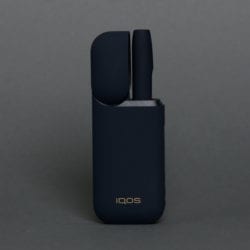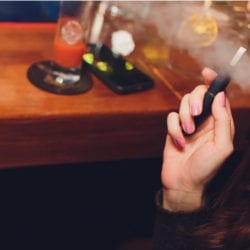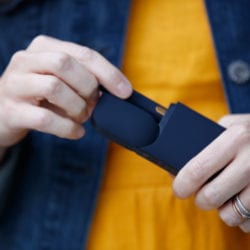Emerging Tobacco Technology
Big Tobacco has added yet another weapon to its deadly and addictive arsenal — a new technology called “heat-not-burn,” (HNB). The most visible example of HNB tech? IQOS — pronounced EYE-kose. Like vapes, these are a stealthy, electronic alternative to the harshness of a burning cigarette.
What’s with the push towards electronic tobacco? To recent generations of Americans, tobacco’s dangers were ingrained from a young age through anti-smoking ads on TV and educational initiatives. Now we’re seeing Big Tobacco’s response, and it looks dangerously deceptive. HNB and IQOS disguise tobacco’s dangers with tech backed up by dubious clinical trials and vague marketing.
Heat-Not-Burn Tech vs. Vape Tech
HNB differs from e-cigarettes and vapes in a few critical ways. For starters, it uses real tobacco that’s processed for heating instead of burning. By contrast, vapes and e-cigarettes use a liquified nicotine formula called e-liquid.
Like vapes and e-cigarettes, HNBs are rechargeable and feature reloading pods or “plugs.” Plus, they’re offered in flavors. Most options closely resemble the flavors we see offered in cigarettes: Smooth Regular, Menthol, Mint, Tropical Menthol and more. This menthol, of course, is the same menthol used to hook millions of users, including a disproportionate number of African Americans.
One more similarity: design. The sleek, subtle look of vapes and e-cigarettes has played a big role in the vaping pandemic. Now, Big Tobacco is positioning HNB as the next piece of high design; yet another way for consumers to express themselves as discerningly chic and tech-savvy. This method has proven successful on the vape market, so why not carry it over?
What is IQOS?
In April 2019, the FDA approved the sale of IQOS, the first HNB product available in the U.S. IQOS is Philip Morris International’s tobacco heating system that uses a specially formulated heated tobacco “plug” that produces a steamy tobacco mist. Philip Morris argues their heating method makes IQOS a safe alternative to cigarettes.
The product itself is sleek and fashionable like JUULs and other popular vapes. IQOS design, branding and marketing ladders up to a product that’s sleek, sophisticated and aspirational. Sound familiar? It’s clear that IQOS is positioned as the Apple of HNB. They want people to associate its clean branding with a clean product — safe and transparent. Nothing to hide.
Do we expect IQOS to catch on? According to a Philip Morris report published in February 2020, worldwide users amount to 13.6 million, 75% of whom Philip Morris estimates have given up traditional smoking altogether. Currently, IQOS is only available in two U.S. cities — Atlanta and Richmond. We can expect IQOS to slowly rollout to more U.S. markets throughout the year.
HNB vs. Cigarettes
This isn’t the first time Big Tobacco has touted the safety of a new, combustion-free tobacco product. Most recently, vaping and e-cigarettes have taken the country by storm, resulting in a staggering epidemic with numerous hospitalizations and casualties. So, how does an HNB like IQOS truly compare with its forerunner, the cigarette?
According to Stanton Glantz, Director of the University of California San Francisco Center for Tobacco Control Research and Education, the FDA never should have approved the sale of IQOS. Turns out, the FDA approved it because IQOS delivers lower amounts of some harmful substances found in cigarettes. Some? What about the others? IQOS actually delivers more of those than cigarettes.
According to Glantz, clinical data on heart rate, blood pressure and breathing show IQOS is virtually indistinguishable from cigarettes. “I don’t see how the FDA approved it,” Glantz told Drugwatch.com. “If it’s indistinguishable from a cigarette in terms of health effects, what do you gain by letting it on the market?”
The early data on IQOS looks grim. What’s grimmer is that this product is poised to hit the market at a time when parents and educators are finally beginning to understand the full ramifications of the vaping epidemic. The nature of unleashing a new product means researchers won’t have a clear idea of its destructive consequences for years.
Vaping Check-In
Vaping and e-cigarettes continue to tear across the U.S., resulting in more hospitalizations and deaths. From March 31, 2019, to February 15, 2020, a total of 2,807 hospitalizations resulting in lung injury from vaping or e-cigarettes were reported from all 50 states. The total number of deaths? Sixty-eight.
The CDC links vitamin E acetate to prfoduct use-associated lung injury (EVALI) hospitalizations. Vitamin E acetate has been found not only in e-liquids of vapes and e-cigarettes, but also in patient lung fluid samples tested by the CDC.
We are several years into the vaping epidemic, and the researchers are still learning about its lethal consequences. On the cusp of heat-not-burn tech’s launch, we have to ask: How do we expect HNB and IQOS to turn out? Clearly, Big Tobacco has no regard for anything but profit.
Big Tobacco Tech
With the introduction of HNB and IQOS, Big Tobacco continues to circumvent science and the law. Their strategy calls for citing carefully selected research that concluded this “miraculous” new technology is safer than cigarettes. They also know verifying these claims in a timely manner is impossible. Meanwhile, their sales and marketing juggernaut is busy peddling an addictive product with the aim of hooking millions.
Get ready, because HNB and IQOS have already tallied millions of worldwide users. We’re fast approaching yet another potential public health calamity with an unverified tobacco-based product, but Big Tobacco sees profit, not people. What can you do to stop them? Visit StopsWithMe.com to learn more.











